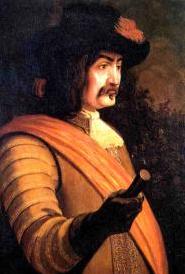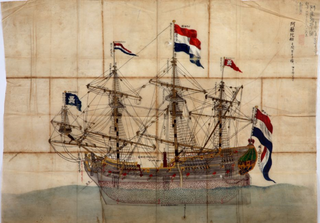Related Research Articles

The United East India Company was a chartered company established on the 20th March 1602 by the States General of the Netherlands amalgamating existing companies into the first joint-stock company in the world, granting it a 21-year monopoly to carry out trade activities in Asia. Shares in the company could be bought by any resident of the United Provinces and then subsequently bought and sold in open-air secondary markets. It is sometimes considered to have been the first multinational corporation. It was a powerful company, possessing quasi-governmental powers, including the ability to wage war, imprison and execute convicts, negotiate treaties, strike its own coins, and establish colonies.

Willem Hesselsz de Vlamingh was a Dutch sea captain who explored the central west coast of New Holland (Australia) in the late 17th century, where he landed in what is now Perth on the Swan River. The mission proved fruitless, but he charted parts of the continent's western coast.
The Eendracht was an early 17th century Dutch wooden-hulled 700 tonne East Indiaman, launched in 1615 in the service of the Dutch East India Company (VOC). Its Dutch name means "concord", "unity" or "union", and was a common name given to Dutch ships of the period, from the motto of the Republic: Concordia res parvae crescunt . The ship was captained by Dirk Hartog when he made the second recorded landfall by a European on Australian soil, in 1616.
Ridderschap van Holland was a large retourschip, the largest class of merchantmen built by the Dutch East India Company to trade with the East Indies. In 1694 the ship sailed for Batavia on her fifth voyage, but did not reach its destination and was never heard from again. She is now thought to have been shipwrecked off the west coast of Australia.

The Prins Willem, also spelled Prins Willim, was a 17th-century East Indiaman of the Dutch East India Company. She was their largest ship at the time. The ship made her first voyage to the Dutch East Indies in 1651. After several voyages, she sank near Madagascar in 1662. A replica of the Prins Willem was built in 1985, but she was destroyed by fire in 2009.
Thirteen ships of the Dutch East India Company and its pre-companies have been named Amsterdam.

Pieter van den Broecke was a Dutch cloth merchant in the service of the Dutch East India Company (VOC), and one of the first Dutchmen to taste coffee. He also went to Angola three times. He was one of the first Europeans to describe societies in West and Central Africa and in detail trade strategies along the African coast.

The Oost-Indisch Huis is an early 17th-century building in the centre of Amsterdam. It was the headquarters of the Amsterdam chamber of the Dutch East India Company. It is a listed Dutch national heritage site (rijksmonument).

Suratte or Soeratte was a directorate of the Dutch East India Company between 1616 and 1795, with its main factory in the city of Surat. Surat was an important trading city of the Mughal Empire on the river Tapti, and the Portuguese had been trading there since 1540. In the early 17th century, Portuguese traders were displaced by English and Dutch traders.

A slave mutiny on Meermin, one of the Dutch East India Company's fleet of slave ships, took place in February 1766 and lasted for three weeks. Her final voyage was cut short by the mutiny of the Malagasy captives onboard, who had been sold to Dutch East India Company officials on Madagascar to be enslaved by the company in its Cape Colony in southern Africa. During the mutiny half the ship's crew and almost 30 Malagasy captives lost their lives.

Meermin was an 18th-century Dutch cargo ship of the hoeker type, one of many built and owned by the Dutch East India Company. She was laid down in 1759 and fitted out as a slave ship before her maiden voyage in 1761, and her career was cut short by a mutiny of her cargo of Malagasy people. They had been sold to Dutch East India Company officials on Madagascar, to be used as company slaves in its Cape Colony in southern Africa. Half her crew and almost 30 Malagasy lost their lives in the mutiny; the mutineers deliberately allowed the ship to drift aground off Struisbaai, now in South Africa, in March 1766, and she broke up in situ. As of 2013, archaeologists are searching for the Meermin's remains.

Willem Jacobszoon Coster was a Dutch colonial governor who served as the first Governor of Dutch Ceylon from 13 March until 17 August 1640. He was succeeded by Jan Thyszoon Payart.

The Landskroon was a ship of the Dutch East India Company (VOC) which traded with Japan in the mid-18th century.

't Vliegend Hert also called 't Vliegend Hart was an 18th-century East Indiaman or "mirror return ship" of the Dutch East India Company. 't Vliegend Hert was built in 1729 in Middelburg for the Chamber of Zeeland. Her maiden voyage was in December 1730, departing from Fort Rammekens (Netherlands) to Batavia, commanded by captain Abraham van der Hart.
Abraham van der Weijden, a Dutch citizen, was a ship’s captain and the initiator of Freemasonry in South Africa.

The Battle of Ronas Voe was a naval engagement between the English Royal Navy and the Dutch East India ship Wapen van Rotterdam on 14 March 1674 in Ronas Voe, Shetland as part of the Third Anglo-Dutch War. Having occurred 23 days after the signing of the Treaty of Westminster, it is likely to have been the final battle of the Third Anglo-Dutch War.
Wapen van Rotterdam was a Dutch East India Company East Indiaman that was built in 1666 for the Rotterdam Chamber of the VOC, and was operated from 1667, twice travelling to the Indies, until its capture by the English Royal Navy's frigate HMS Newcastle on 14 March 1674 in the Battle of Ronas Voe.

SS Veendam was a 15,450 GRT ton ocean liner built for the Holland America Line. Built in 1922 by Harland & Wolff Limited, in Govan, Glasgow, she would operate on transatlantic routes between New York and Rotterdam via the Caribbean Sea. In 1941 she was seized by the Kriegsmarine as an accommodation ship and in 1945 after heavy damage, she was returned to her former owners the Holland America Line. She would go on to serve for another eight years before she was scrapped in 1953 at Baltimore, Maryland. She was the sister ship of SS Volendam.

Candia was a ship of the Dutch East India Company which only once traveled for Asia in 1790 and never returned to the Netherlands.
Horssen was an East Indiaman operated by the Delft chamber of the Dutch East India Company. She was launched in 1784 and made the voyage to the Far East in 1786. She then had sailed for several nearby ports in Asia, when she finally set out for the successful return voyage in 1791, carrying aboard the prisoner Mary Bryant to Cape Town. After arriving in Europe in 1792 she was put out of service.
References
- 1 2 "De VOCsite : gegevens VOC-schip Hofwegen (1731)". www.vocsite.nl. Retrieved 2018-12-31.
- ↑ "VOC-Kenniscentrum - Kamer Rotterdam". www.voc-kenniscentrum.nl. Retrieved 2018-12-31.